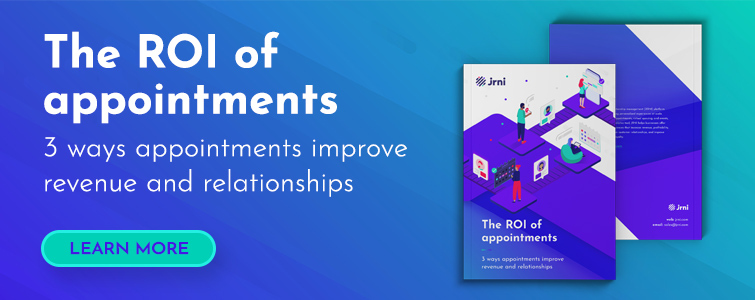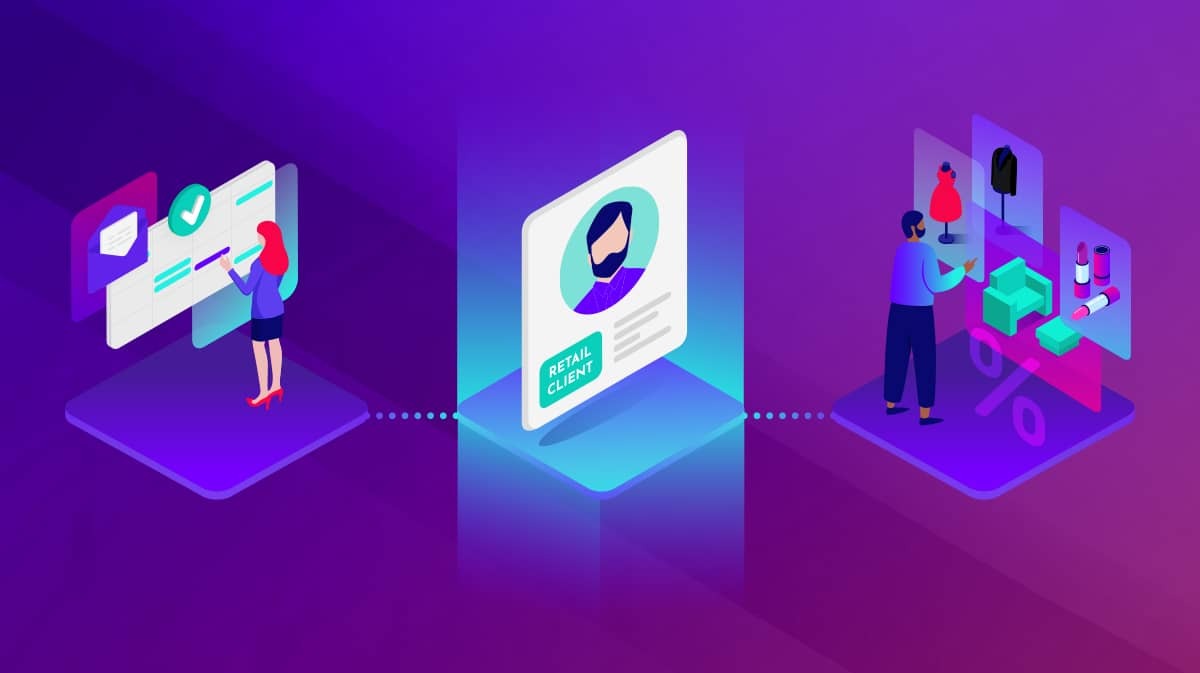Appointments can redefine how you interact with your customers and how you run your business at a high, strategic level.
But implementing appointment scheduling software is only part of the job. It’s not solely about the technology. It’s about the processes you build around it, how different teams interact with it, what the guardrails around it should be, and so on. Done correctly, it affects and benefits multiple teams across organizations.
Let’s look at how different teams across service-based businesses, such as retailers or banks, can use appointment scheduling to improve service and make their teams more effective.
Appointment scheduling for staff
Your staff are on the frontlines, interacting with customers every day and serving them during appointments. It’s crucial that appointment scheduling software gives them tools to make every appointment even more valuable. Here are a few ways it can do just that:
Make the customer experience more personal
Whether you’re a retailer who wants to create a powerful personal shopping experience, or a bank that wants to ensure your customers feel taken care of when solving complex problems, appointments are geared for a personal touch. One of the most surefire ways to improve conversion rates and basket size is by providing appointments where trained staff can give a customer personal attention and help make the best choices for them.
Build long-term relationships through appointments
Appointments are a prime opportunity to build deep relationships with customers. eCommerce may be convenient, but personal attention is something that even Amazon can't do. Successfully using appointment scheduling is a matter of using customer data to inform every interaction.
When a customer returns to a store, staff have crucial information like past purchases, interests, sizes, etc. at their fingertips to ensure every appointment feels like a continuation of the relationship. By increasing the value of every interaction for the customer, you increase their lifetime value to your business.
Gather real-time feedback
An appointment scheduling solution should include the ability to send follow-up surveys after each appointment. Feedback is critical for relationship-based businesses, such as retailers or banks. Allowing your staff to get feedback will help them hone their approach to serving customers, identify weak points in the service model, and understand how customers feel about your products and offerings.
Appointment scheduling for marketing teams
Corporate marketing teams gain a powerful asset when their companies implement appointment scheduling. Here’s how marketing teams are using appointment data to fuel their efforts.
Improve customer segmentation
Appointment scheduling software will let you keep records of customer appointments, including what they bought. This data is powerful for segmenting out your best customers for additional promotions. Beyond that, you can segment customers based on what products they show interest in and use that data for email list and ad targeting. This can help expand revenue opportunities in your existing customer base, rather than solely relying on new customer acquisition for growth.
Integrate with CRM
Tracking individual customer relationships based on appointments can be difficult if you don’t have easy integration with your CRM software. You’re either relying on staff to manually input customer interactions into your CRM, or you have multiple sources of “truth” in disparate systems. Appointment scheduling and CRM integration ensures real-time syncing of customer booking information for new and existing customers.
Increase conversion rates
Appointments are a powerful promotional tool for marketing teams who need to help drive traffic to stores, not just websites. Additionally, appointments booked is a powerful metric to validate the UX and conversion rates of digital channels.
Appointments are high-value actions due to their impact on customer lifetime value and increased basket sizes. Marketing teams can influence this by promoting appointments and driving high-value users deeper into the funnel.
Appointment scheduling for regional management
Appointments can simplify store operations and give regional managers several ways to improve efficiency and customer service at their locations. For regional managers, appointments can be a way to improve profitability and efficiency by more effectively allocating staff resources.
So what can regional managers use appointment scheduling for? Here are a few key things:
Reduce downtime
Employee downtime occurs when there are too many staff members on the clock for the work that needs to be done at that time. Appointments help reduce downtime in two key ways: You can offer appointments during known lull times to smooth the peaks and valleys of foot traffic, and you can reduce your staff levels to an appropriate point during times when customers simply aren’t coming into the store. Additionally, when customers come in for appointments, you know your employees will be engaged with them, ensuring that there’s minimum downtime.
Set hours of operation
Appointment volume can be a useful metric for determining hours of operation. For example, if you notice that you get very few appointments on Mondays, and that dovetails with lower foot traffic overall, you have a compelling case to close business on Mondays.
Reduce no-shows
One of the downfalls of manual appointment setting is that appointment reminders are also a matter of having staff make follow-up calls. By contrast, appointment scheduling software sends automated reminders via text or email so customers get timely appointment information. This reduces the likelihood they no-show. With a reminder, they can easily reschedule or cancel in advance if they’re unable to make the appointment.
Increase regional revenue
Appointments increase basket size and revenue, so regional managers who need to show growth can turn to them as a means of improving revenue numbers.
According to JRNI’s Consumer Behavior Research, 64% of respondents said they typically spend or invest more in products after they’ve had a personalized appointment. One leading retailer, Jojo Maman Bébé, used appointment scheduling to increase overall appointment volume by making it easier to book from the website. They found that the conversion rates of appointments were higher than those of walk-ins, with 60% of customers making a purchase after an appointment.
A study from Forrester Consulting looked at the Total Economic Impact™ of using JRNI. The researchers tracked results for a major enterprise with over $3 billion in revenue and 200+ locations. The results over three years include:
- 60% annual increase in appointment volume
- $3.1 million in increased profit from appointments
- 143% ROI
Read the full study here.
Manage and even out foot traffic
For now and the foreseeable future, COVID-19 is impacting how businesses can serve customers on-location. It’s not just about making people wear masks or implementing a limit on occupancy. Research from McKinsey showed that consumers are still worried about shopping, and are avoiding out-of-home activities that aren’t essential. When they do go out in public, whether to a store or to the bank, they are looking for visible signs that businesses care about safety.
Managing traffic flow has always been essential for businesses to run smoothly, but due to the safety concerns caused by COVID-19, it has only increased in importance. Appointments are one way to alleviate consumer concerns about safety. They can be a replacement for walk-ins, or can give customers the option to have a 1-1 meeting with a staff member, rather than have to wait in lines.
Additionally, remote appointments are a powerful alternative for customers who want a face-to-face meeting, but aren’t comfortable actually doing it in-person. Businesses that can offer these options and give customers more flexibility will have an advantage until we reach a point where medical officials remove their restrictions.
Appointment scheduling for operations
Appointments require an operational commitment. They aren’t just an add-on to your existing business. Here’s how operations teams can leverage appointments to improve how their businesses run.
Create an omnichannel experience
Brick-and-mortar stores aren’t dead. They’re being put in their proper place as a part of the customer journey. They’re a distinct touchpoint and should be treated as such. The hard part for businesses is that seamlessly getting users from digital channels to physical ones is difficult. Appointment scheduling software can be a powerful connection between online and physical channels, creating a true omnichannel experience.
With appointment scheduling integrated into digital channels, customers can use digital channels to research, compare, and identify possible items to purchase. If they want to go deeper, or get support on a complex decision, appointment scheduling is a few clicks away. This helps them connect their online activity with face-to-face, in-store interactions.
Identify profitable services
Understanding what services and products customers care enough about to book an appointment for can be a guide to where your competitive advantage is. These are likely profitable offerings that people are willing to pay more for.
Operations and product teams can use this data when improving existing offerings or looking for new, complementary products they can introduce.
Appointment scheduling goes beyond the interaction between staff and customers. It can unlock new opportunities across multiple business units, even those that don’t directly work with customers. It can improve revenue and profitability, drive a deeper understanding of your customers, and make operations more efficient. Before you deploy appointment scheduling, make sure you understand how different teams can leverage appointments and the resultant data so you can make the most of it.




